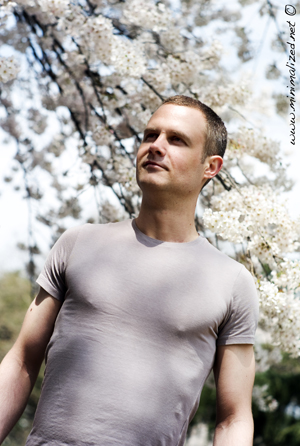Twist and shape your body into gravity-defying poses, breathe deeply and hold the pose: yoga is here to stay, and the movement has taken over Tokyo in all shapes and forms possible.
Despite its trendy image, yoga has been practiced for over 5000 years and can hardly be called a mere fad. Combining exercise, breathing and meditation, yoga aims to bring together the body and mind in harmony, constituting an excellent workout to build strength and maintain a healthy weight.
There are over a hundred different schools of yoga, each of which has a different spin on the basic elements. In Japan, the most popular type is Hatha Yoga. Hatha is one of the original six branches of yoga (the other ones are more focused on meditation) and it takes a basic and classical approach.

Dylan Robertson (photo: Benjamin Robbins)
Yoga in Japan
Dylan Robertson, from HelloYoga.com, an organisation which caters to Tokyo?s English speaking yoga community, explains: ?Yoga has a long history in Japan. It had some popularity in the 1980s but was generally still seen as something alternative. Yoga then boomed and became mainstream in the 1990s in the US. Typically, these kinds of trends take about five years to come to Japan but, in this case, it was delayed due to the Aum Shinrikyo cult and their incidents which gave yoga a bad image.?
?But yoga started to gain popularity from the early 2000s in Japan, influenced by its boom in the US and Europe ? as well as by Hollywood stars and other celebrities doing it.
Various Japanese who had studied yoga abroad started coming back to Japan too, and I?d say it peaked around 2005. It seemed like everyone was trying it and lots of studios sprang up,? adds Robertson, ?and a wide variety of businesses sought to cash in.?
What is the place of yoga in Tokyo today? ?These days, the flurry of people wanting to try it because it?s seen as something new and trendy has subsided. Whilst the hype has died down, though,? Robertson says, ?yoga has continued to spread and has become something mainstream. Yoga teacher training courses are more popular than ever and they are continuously churning out graduates.?
Health Benefits of Yoga
Yoga is thought to develop and improve flexibility, strength, concentration, breathing, posture and balance. Desires for relaxation or weight-loss seem to be the most common reasons to take up yoga. Professional sportsmen and women swear by it too, and Olympians will be practising strands of Yoga as part of their training regime; yoga is said to loosen up the muscles and improve flexibility, as well as helping an athlete maintain mental strength.
Whether you want to unwind and de-stress from the fast-paced city life, burn calories from one too many meals, or tone up your muscles and increase their elasticity, yoga offers a vast array of merits to fit everyone?s lifestyle. Take off your socks, unroll your mat and stretch away.

Mass Yoga in New York, can Tokyo compete?
Whilst the most popular form of yoga in Japan is Hatha, other styles include Ashtanga Vinyasa Yoga and the many variations and interpretations it has produced, including Power Yoga.
Confused? Here is a little run down of what you need to know about the most well-known styles.
Ashtanga Yoga
Particularly good if you?re interested in losing weight, Ashtanga yoga (Sanskrit for ?eight-limbed?) is a system popularized by K. Pattabhi Jois, which is often promoted as a modern-day form of classical Indian yoga. Ashtanga has six established and strenuous pose sequences, each incorporating some swift movements.
Bikram (Hot) Yoga
Bikram yoga is a system of yoga that Bikram Choudhury synthesized from traditional hatha yoga techniques which became popular in the early 1970s. Bikram classes usually run for around 90 minutes and consist of a set series of 26 postures and two breathing exercises. Bikram Yoga is ideally practiced in a room heated to 40.6?C. Toasty.
Power Yoga
Power yoga is a general term used to describe a vigorous, fitness-based approach to vinyasa-style yoga. Though many consider it to be ?gym yoga,? this style of practice was originally closely modelled on the Ashtanga method. Power yoga does not follow a set series of poses, so classes can vary widely and generally focus on on strength and flexibility.
Vinyasa (Flow) Yoga
Vinyasa yoga, in which movement is synchronized with breathing ? each movement in the series is made on an inhalation or an exhalation ? is a term that covers a broad range of yoga classes. This style is sometimes also called flow yoga because of the smooth way the poses run together and become similar to a form of dance.
By Vivian Morelli
Many thanks to the kind and knowledgeable people at Helloyoga.com, Sunroom Yoga and the Tao Yoga Academy for helping us put together this article. Also check out the HelloYoga.com Facebook page and the Sunroom Yoga page for more from Tokyo?s Yoga community.
The Picture of Dylan Robertson above was taken by Benjamin Robbins. More of his work can be found here.
Source: http://www.tokyoweekender.com/2012/08/yoga-in-tokyo-2/
lottery winners lottery winners april fools day pranks ohio state vs kansas daniel von bargen the beach blood diamond
No comments:
Post a Comment
Note: Only a member of this blog may post a comment.